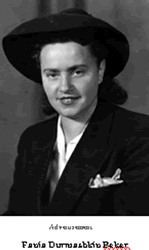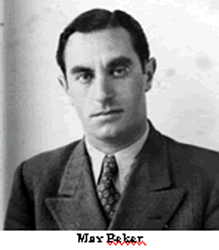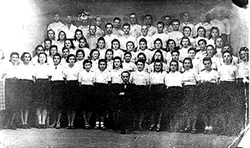The Durmashkin-Beker- Gurko family
Fania Durmashkin-Beker
The Durmashkin family's home was constantly full of music. Fania Durmashkin's father, Akiva Durmashkin, was a well-known choir director of Vilna's Great Synagogue. He wrote cantorial music and collaborated with Poland's well-known cantors -- Sirota, Rontal and Elphand -- and the great American cantors, Rosenblatt and the Koussevitzky's came to the house to work with him. Her brother, Wolf, and she would often accompany them on the piano as they created cantorial pieces. Singers and violinists often gathered at the house to make music Wolf, whose piano, conducting and composition talents were renowned. People actually gathered in the street outside the house to listen as music was being practiced and performed inside their home.
Fania's passion was the piano, and, like her brother, she studied at the Vilna Conservatory of Music. They had two pianos at home and, and she and her brother both loved to practice, often at overlapping times. So that they wouldn't disturb each other, Wolf would stuff the cracks in the door to try to muffle one another's piano sounds. Fania attended the Yiddish Real Gymnasium as well. She gave piano performances in public. In 1939, the Lithuanian Army came to Vilna, then the Russians took it over. At that time, she performed for the Russian army with her teacher, Professor Kruveh, playing Schumann's concerto for two pianos.
On June 21, 1941, the Nazis marched into Vilna and took it over. The Durmashkin family was eventually herded into the larger of Vilna's two ghettos. As they were marched through the streets to the ghetto, Fania saw a man who had hanged himself from a telephone pole. The man was Dr. Gershuni who committed suicide on Sept. 6, 1941 after stating that this was the punishment given to the Jewish people for not having settled in Israel.
Privation, disease and starvation quickly took over the ghetto population. The Nazis conducted "aktions" where they'd snatch people off the ghetto streets and send them to Ponary, Vilna's killing field, to be shot. The Durmashkins shared a small apartment with five other families. Wolf was the conductor of the Vilna Symphony Orchestra at the time, and the Orchestra members refused to do without him. He received official permission to continue conducting the Orchestra in the symphony hall outside the ghetto, and was taken back and forth for performances under Nazi guard. He asked my mother to write out his music and carry it for him on these occasions, for which she also received special permission, and this gave her a chance to catch further glimpses of the outside world.
In the Vilna ghetto, there were musicians, artists, poets and writers who had been the cream of the city's Jewish cultural community. Wolf Durmashkin formed a 48-member symphony orchestra in the Vilna ghetto. He performed with and conducted them. While on work units outside the ghetto, he managed to find much needed instruments for the musicians, and smuggled them into the ghetto at great personal risk. Wolf also had to find a piano. A work unit of musicians actually found a piano in a deserted house, probably originally a house of Jews who had been executed. They took the piano apart piece by piece, smuggled it back to the ghetto theater and reassembled it there. This was the piano that Fania and others played for performances organized by her brother.
In September 1943, the Vilna ghetto was liquidated. Fania and her sister, Henia, were separated from their beloved family members and taken to Riga, Latvia to a work camp near Kaiserwald, then to Dinawerke, Stutthoff, finally to Kaufering/ Dachau in 1944, then Landsberg, Lager 1. In March 1945, as Germany was being defeated by the Allies, many Dachau inmates, including Fania and Henia, were taken on a death march by their Nazi captors. They were marched without stopping, and if anyone faltered, they were shot. Suddenly, the march was intercepted by American tanks -- the Nazi captors ran away, and the inmates were freed!!
Fania and her sister found themselves in the Landsberg DP camp in the American zone. They became part of an orchestra consisting of Kovno and Vilna musicians. Eventually, Max Beker also joined the DP camp and the orchestra as a violinist. The Ex-Concentration Camp Orchestra performed for other DP camp inmates, the Nuremberg tribunal, Ben-Gurion and Golda Meir, and were conducted for two concerts by Leonard Bernstein, who found them on a cultural mission after inquiring at the Jewish Agency if there was a survivor's orchestra he might contact.
Eventually, Fania and Henia joined Max Beker in Brooklyn, NY in 1950. Henia met her husband-to-be, Simon Gurko, on the ship coming to America. Fania and Max were married in Brooklyn, had a daughter, Sonia, and continued to play music for friends and at survivor gatherings.
Max Beker
Sonia Beker is the daughter of Max Beker and Fania Durmashkin-Beker. Both of her parents grew up in musical families in Vilna. Fania was the daughter of Akiva and Sonia Durmashkin. Akiva was a cantor, teacher and composer. Fania had two siblings, Henia and Wolf. All three children received both Jewish and musical educations. Fania studied piano, and her sister Henia studied voice at the Vilna conservatory.
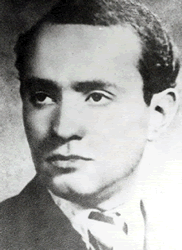
Wolf Durmashkin
Their brother Wolf was a child prodigy who began performing piano at young age. He studied composition, performance and conducting at both the Vilna and Warsaw Conservatories, and while still a young man, he became the conductor of the Vilna Symphony Orchestra. In September 1941 all the Jews in Vilna were forced to move to a ghetto. However, in response to a petition from the Vilna Orchestra, Wolf was allowed to leave the ghetto to continue as their conductor. One day the head of the ghetto, Jacob Gens summoned Wolf Durmashkin and asked him to create a ghetto orchestra to improve morale. Wolf also organized a 100 voice choir for which he wrote Hebrew songs. His conducted the first concert in the ghetto on March 15, 1942 in which his sister Fania performed the Chopin piano concerto. The orchestra's final concert was held on August 29, 1943, three and a half weeks before the ghetto was liquidated. In September, Germans held a selection choosing those capable for forced labor. All others, including Fania's parents, were taken to the Ponary forest and killed. Akiva was 56 years old, and Sheine only 53. Wolf was sent to Klooga, a work camp in Estonia. Shortly before the camp's liberation on September 19, 1944, German guards bound all the prisoners, shot them and burned their bodies. Wolf was 31 years-old. Fania and Henia were shipped to Kaiserwald, a camp on the outskirts of Riga Latvia, where they worked building cement canals. From there they were sent to Dinawerke, Stutthof, Dachau and Landsberg concentration camps. Fania was fortunate to obtain a job cleaning the home of Nazi doctor who treated her kindly. Shortly before the end of the war, guards marched all the prisoners out of the camp on a death march. One day, the guards ran away and the prisoners were liberated.
Max Beker was the son of Berel and Pessiah Beker. His father Berel played oboe in the Vilna Symphony Orchestra, and his uncle Max was a composer. Berel and Pessiah had seven children: Leib, Max, Sonia, Yisroel, Rochele, Perele and Noachel. Like the Durmashkins, the Beker children attended Jewish schools and also studied music. Max studied violin at the New Jewish Institute and before the start of World War II performed in coffee houses and music halls. After the start of the war, he was drafted into the Polish army and soon taken prisoner. He was sent to a number of different prisoner-of-war camps and eventually came to Stalag VIIIA near Gorlitz. Jews and non-Jews were treated separately; the former used to break stones for concrete, work on farms and build roads. Max discovered however that the camp had a small orchestra composed of non-Jewish musicians. The camp commandant encouraged the music since it provided good public relations, to show to the Red Cross. When Max told the conductor that he was a professional violinist, he received permission to join the orchestra as well. The ensemble rehearsed three times a week and performed twice a week. After joining the orchestra, Max's quality of life noticeably improved. He was exempt from heavy labor and allowed to sleep in real barracks. He performed with the orchestra for two and a half years. He even received care packages from the family of a young Belgian violinist with whom he was friendly. In 1944 French and Belgian prisoners began to leave the camp and return home, and the orchestra disbanded. Max was sent to a new camp nearby but without the privileged status of a musician. He however was permitted to write a letter once a month as a prisoner-of-war. In response to a letter home, he discovered that the Germans murdered his entire immediate family in the forests of Ponary. In April, the POW camp was liquidated and the prisoners were sent on a death march. Max was liberated on April 15, 1945 by American forces. By coincidence, his liberator not only was a Jewish captain, but also lived on the same street in Brooklyn as Max's aunt. He sent a letter to her from Max, and the aunt began the process of sponsoring his immigration to the States. After his liberation Max first traveled to both France and then Poland but eventually decided to return to Germany to meet up with other Jewish survivors. He soon heard rumors that a group of Jewish musicians, primarily from Lithuania, had established an orchestra in the St. Ottilien monastery near the village of Schwabenhausen. Originally a Nazi hospital, Dr. Zalman Grinberg from Kovno with help Rabbi Klausner set up a convalescence home for some 420 Jewish prisoners, including Fania and Henia Durmashkin. Max joined the orchestra as a violinist and assistant manager and fell in love with Fania. After a year the orchestra moved to Fuerstenfeldbruck, and in 1948 they performed under the baton of Leonard Bernstein. The following year, Fania and Henia made plans to immigrate to Israel, but Max persuaded them to join him in America. Max and Fania married, and Henia met married Simon Gurko who she met on the boat. Once in the United States, Max was unable to find work as a violinist and instead went to work in the garment industry.
Akiva is sitting at the bottom
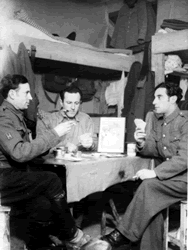
Jewish POWs play cards inside their barracks. Max Beker is pictured on the right.
[Source: Beker, Sonia Pauline, "Symphony on Fire"; New Milford: The Wordsmithy, 2007.]Date: 1941 – 1942 Locale: Goerlitz, [Silesia] Germany
Credit: United States Holocaust Memorial Museum, courtesy of Sonia Beker
Film on Displaced Persons Orchestra to premiere
Vivian Reisman can picture the emotional Friday night get-togethers at her early childhood home in Weehawken as if they were yesterday.
"They always started out so cheerful, with all the music and the singing and eating everything my mother cooked. Everyone brought instruments. It was an impromptu concert," said the Englewood Cliffs resident.
But as the evening wore on, and they sat around the dining room table reflecting on all they had endured, Reisman, the oldest of Henny ( Henia nee Durmashkin) and Simon Gurko's three children, said, "they always ended with the same horrible sobbing."
Reisman recalls eavesdropping on her parents and their Shabbat visitors, Eastern European immigrants who included Reisman's aunt, Fania nee Durmashkin, and uncle, Max Becker. Hidden behind the door of the bedroom she shared with her sister, Rita Lerner, just 13 months her junior, Reisman was riveted by their stories of suffering and loss.
The inconsolable grief of one couple, in particular, haunted Reisman. They, too, had had two daughters. When there was a selection targeting all those who were 10 years old and younger, the couple's older girl, 13, decided to leave her parents behind rather than let her sister die alone.
Lerner, who today lives in Englewood Cliffs, said, of the little she remembers overhearing before she fell asleep, "I had to block it out. It was too painful."
As they grew up, the sisters — and their younger brother, Abe Gurko, of Manhattan —learned more about the devastating history that connected their mother, a vocalist born Henny Durmashkin in 1930, as well as their aunt, a concert pianist, and uncle, a violinist, to a close-knit group of professional musicians.
Liberated by American soldiers following a death march from Dachau in the spring of 1945, the Durmashkin sisters, the only two members of their famed Vilnius musical family to survive the Holocaust, became part of the Displaced Persons Orchestra at St. Otillien. The Bavarian town was the site of the monastery where the refugees were interned from 1945 to 1948.
The group's extraordinary story is the subject of a new documentary, "Creating Harmony: The Displaced Persons Orchestra at St. Otillien," which will have its world premiere at the Museum of Jewish Heritage-A Living Memorial to the Holocaust in New York on Sunday, June 10, at ':30 pm.
Lerner began to cry as she described how the grandmother she never knew, Sonia Durmashkin, was sent to the gas chamber after the family was deported from the Vilna Ghetto to a concentration camp. "My mother and aunt tried to apply makeup to make her look younger, but it didn't work," Lerner said in a telephone interview. Pausing briefly, she added, "This gets so emotional for me."
Lerner continued: Her grandfather, Akiva, the cantor of Vilna's main synagogue and respected composer of liturgical music, had been shot by the SS several years earlier at Ponary, a village on the city's outskirts. Her uncle, her mother's older brother Wolf, who had been a child prodigy and conducted the Vilna Philharmonic, was so brilliant a musician and composer that he was given special dispensation to come and go from the ghetto so that he could entertain audiences that included his Nazi captors. A partisan, he managed to smuggle a piano into the ghetto so that Jewish cultural life could continue. He was shot an hour before liberation, said Lerner, in Klooga, a concentration camp in Estonia.
Lerner's mother, the youngest of the three siblings and in training to be an opera singer before the war, was fluent in eight languages. Years later, after raising her children, Gurko completed the education that was interrupted, earning degrees from the Jewish Theological Seminary and Columbia University. She eventually went to work as a Hebrew school teacher.
Lerner recalled that her mother filled their home with music. "She was never negative or bitter, even though life was hard for them here at first, not knowing the language and without any help. Anything she could possibly sing, in any language, she sang for us."
Although Gurko died in '00' before she could be interviewed for the film, footage of her is included from testimony recorded for the museum's archives. The archives also contain artifacts she donated: posters announcing the orchestra's concerts and photos of herself with conductor and composer Leonard Bernstein.
Others featured in the film, written and produced by John Michalczyk and Ronald A. Marsh, are flutist David Arben, a surviving member of the orchestra who spent his career at the Philadelphia Orchestra, thanks to a scholarship to the Curtis Institute of Music arranged by Bernstein, and the D.P. Orchestra manager, Jascha Gurewitz. A lot of the filming was done at the museum, said Lerner, a board member who was interviewed there for the film, along with her first cousin, Sonia.
How the orchestra, which was first known as the orchestra of survivors and later as the ex-concentration camp orchestra, got started was unclear to Lerner. She said she believed that the musicians connected with each other through word of mouth in the refugee camp. Nor did she know how they acquired instruments or funding for their concerts.
But, said Reisman, their mother often spoke about the fact that "music kept them going after liberation. It helped them to reconnect with what for them represented the normalcy of their lives before the war and gave them great fulfillment to bring music to survivors, helping to restore their faith and leading them down the long road of healing."
It wasn't long before the orchestra gained renown in Europe and abroad for its stirring arrangements of popular Yiddish and Hebrew music, with vocal performances by Henny Durmashkin. Among its fans were two people who would become leaders of the future Jewish state, David Ben-Gurion and Golda Meier.
Bernstein, whose star was rising in the United States, was another. In Munich after the war, Bernstein requested special permission to conduct the musicians. Bernstein managed to join them for three concerts, one in Munich and the other two at Landsberg and Feldafing, two refugee camps that had been sub-camps of Dachau. He accompanied Durmashkin on the piano, but only when she agreed to sing in Hebrew, not Yiddish, she related years later to her children, even though she became known to crowds as "Little Raiseleh," after a Yiddish song she helped make popular. (Lerner speculated that Bernstein's preference for Hebrew stemmed from his Zionism.)
Of the orchestra's experience playing with Bernstein, Reisman said, "My mother said it was incredible, moving. For a brief moment in time, Leonard Bernstein made them feel they could leave behind the hell they had lived through and soar into the magical world of music they loved so much. He left an indelible mark on her soul as well as an amazing legacy."
The orchestra's performance at the Nuremberg Opera House attracted the attention of the international media, in the city to cover the war crimes trials. To highlight Nazi brutality, orchestra members, whose physical scars were still visible, wore the tattered remnants of their concentration camp uniforms on stage.
After Durmashkin left Europe (she met her future husband on the voyage to the United States in 1949), it wasn't until years later, when she was invited to sing Hatikvah and The Star Spangled Banner at the dedication of the Museum of Jewish Heritage, that she performed again in public. Although, Lerner related, "she and her sister did cut an album, 'Songs to Remember,' a collection of Holocaust, Hebrew, and Yiddish music that are still played on Yiddish radio stations in Israel and elsewhere." They also entertained at an annual gathering of ?migr?s from Vilna.
Tickets to the screening of "Creating Harmony," at $10 per person, $7 for students/seniors and $5 for museum members, may be purchased online at http://www.mjhnyc.or
Twenty-five years ago, two sisters Vivian Reisman and Rita Lerner gave birth to first kids at the same time. When they brought home their bundles of joy, they noticed that most of the layette and infant items were made out of synthetic fabrics. This was not acceptable, as they wanted 100% cotton next to their babies’ skin. Hence, they created Baby Steps a cottage industry that they have since nurtured into a steadily, growing kids clothing company.
“We first set out to find the softest 100% cotton that would hold up to our endless washer and dryer tests,” says Vivian. Then they began designing a collection of functional and fashionable infant and toddler basics featuring sophisticated mix and match prints. “The baby boomers were educated consumers and spared no expense for their kids,” continues Ms. Reisman. “We designed things that we loved and also realized that there was a void in the market,” Rita adds. “The timing was right for real moms to impact the kids industry.” With a small investment and the confidence that they were onto something, they launched their first season to a resounding success.
The company is currently experiencing another growth spurt with the addition of Mish Mish, a ready-to-wear collection that the sisters discovered while traveling abroad. The fashion forward collection offers a wide range of styles for boys and girls in sizes infant to teen. “Today’s mothers want their kids to look stylish not trendy,” says Vivian. “Mish Mish is a fresh, new brand that evokes a lifestyle—European styling, great colors, cool details at a reasonable price point.” Vivian and Rita have proven once again that they have their finger on the pulse of what mothers want for their kids. They have tapped into the current market, which is the baby boomers’ babies who are having babies.
Henny Durmashkin (Gurko) 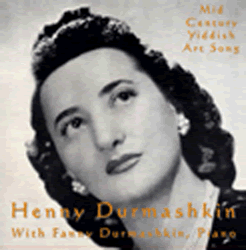
Singer. Born 1924- Died, 2002 in Englewood Cliffs, N.J. Sister of pianist Fanny Durmashkin and conductor Wolf Durmashkin. Henny was the youngest. Her grandfather, Akiva, was the cantor of Vilna’s main synagogue and respected composer of liturgical music. Before the war, Henny had studied opera. She was fluent in 8 languages. Her brother, Wolf Durmashkin, had been prominent in Vilna's cultural, conducting the Vilna Philharmonic, prior to the ghetto life during WWII. In the ghetto, he directed a Hebrew choir and an orchestra in the ghetto. According to Barbara Durmashkin, Wolf perished at the age of 30, on Sept. 19, 1944. He was shot an hour before liberation of the Klooga concentration camp. During its 15 months in existence, the Ghetto orchestra performed 35 chamber and symphonic concerts. The last one took place on Aug. 29, 1943, three and a half weeks before the Ghetto was liquidated. "Liberated by American soldiers following a death march from Dachau in the spring of 1945, the Durmashkin sisters, the only two members of their famed Vilnius musical family to survive the Holocaust, became part of the Displaced Persons Orchestra at St. Otillien. The Bavarian town was the site of the monastery where the refugees were interned from 1945 to 1948." (Jewish Standard--http://www.jstandard.com/articles/2780/1/%91Music-kept-them-going%92) A documentary about the lives of those in the orchestra,"Creating Harmony: The Displaced Persons Orchestra at St. Otillien," had its premiere in summer 2007 at the Museum of Jewish Heritage. Henny met Simon Gurko in 1949, and married him. Henny recorded the album Songs To Remember. She was the mother of Vivian Reisman, Rita Lerner and Abe Gurko. Thursday, Sept. 11, 1997 the Museum of Jewish Heritage -- A Living Memorial to the Holocaust was dedicated. Henny sang the Star Spangled Banner. Henny later donated artifacts to the archives of the Museum of Jewish Heritage including posters from the ghetto orchestra concerts and photos of herself with conductor and composer Leonard Bernstein. She died in the US. Henny Durmashkin's obituary was published in Forward, Aug. 23, 2002 by Alana Newhouse under title, "Henny Gurko, 78, singer who serenaded inmates." (aka Henny Durmashkin) If anyone has more biographical information about this singer, please forward to JMWC. Thanks.
GURKO-Henny Durmashkin. The Trustees and Staff of the Museum of Jewish Heritage A Living Memorial to the Holocaust, mourn the passing of Henny Durmashkin Gurko, beloved mother of our Trustee, Rita Lerner. We extend our heartfelt condolences to Rita and her family. Robert M. Morgenthau, Chairman David G. Marwell, Director.
-----------
The conductor gazed down at the orchestra, waved his baton and the stirring sounds of Grieg's "Triumphal March" began to fill the air. As Max Beker guided the bow over the strings of his violin, Fania Durmashkin's fingers moved expertly across the piano keys. But on May 27, 1945 these accomplished musicians from Vilna, Lithuania, who had contributed so much to the classical and Yiddish musical traditions of their culturally rich city, weren't performing in the rarified atmosphere of the Vilna Concert Hall. Today they were playing the familiar melodies of home, recalling the life they had lived before the world descended into madness, on a makeshift stage erected on the grounds of the St. Ottilien Monastery in Bavaria, Germany.
Seated among the hungry, the sick, and the broken, who had gathered for a concert by survivors for survivors to commemorate their liberation, was Robert Hilliard, a 19-year-old American GI who was stationed on an army base located a few miles from the St. Ottilien Displaced Persons' Camp. As the editor of the base newspaper, he had come to the Liberation Concert in pursuit of an interesting story. Little did he realize on that fateful day, that he would become a vital link in a miraculous chain of events that would ultimately span over 60 years.
Advertisement
Fania Durmashkin Beker
Hilliard described the performance as "A liberation concert at which most of the liberated people were too weak to stand. A liberation concert at which most of the people still could not believe they were free.... A concert of life and a concert of death The movements and faces of the musicians were cramped, tight, fearful as if they momentarily expected guns and clubs to tear apart what, after so many years, must have felt to them like only a dream. When the concert ended many people were crying, few more openly than I."
But Hilliard did more than just cry. Overwhelmed by the misery he had just witnessed he returned to the base determined to correct the abysmal conditions in the DP camp. He enlisted the help of a fellow GI, E. Edward Herman and together, they devised a plan that not only alleviated the suffering of survivors at St. Ottilien but eventually succeeded in changing the U.S. military's policy toward all of the DP camps. The details of their courageous efforts are revealed in Hilliard's memoir, Surviving The Americans: The Continued Struggle of the Jews After Liberation.
Although they had left Germany by the time that I was born in the DP Camp, I finally met these two men who had made such a major impact on the lives of survivors when they reunited with St. Ottilien alumni in the year 2000. Footage of the emotional reunion was included by John Michalczyk, co-director of the Film Studies Program at Boston College, in his award winning documentary, "Displaced: Miracle at St. Ottilien," which was based on Hilliard's book.
It is at this point that the past and the present converge - when paths cross, lives intersect and fate reveals its guiding hand. While Sonia Beker was doing research for a book she was writing to honor the memory of her parents, Max Beker and Fania Durmashkin, the Vilna musicians who met at the St. Ottilien DP camp, she learned of the existence of the documentary. This discovery led her directly to former GI, E. Edward Herman, who immediately recognized the need for a sequel based on the wealth of material in Sonia's newly published book, Symphony on Fire: A Story of Music and Spiritual Resistance During the Holocaust available from Amazon.com.
In her profoundly moving memoir, Sonia Beker chronicles the lives of her parents from their musical beginnings in Vilna, their incarceration in the Vilna ghetto, the concentration, labor and Nazi POW camps, their meeting at the St. Ottilien DP camp and finally, the new life they built together in America. Rich in personal photographs, letters and documents, she paints an intimate and loving portrait of both the Durmashkin and the Beker musical family dynasties against the historical backdrop of the thriving Jewish community of Vilna.
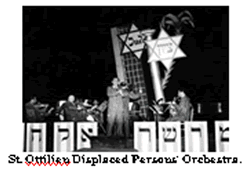
St. Ottilien Displaced Persons' Orchestra.
Sonia writes of her parents: "When the Holocaust destroyed their nurturing, loving families and came close to destroying them as well, music was their passport to survival and transcendence They performed as members of a Jewish orchestra for the Nuremberg tribunal, for David Ben Gurion and Golda Meir, and for DP camp inmates throughout Bavaria. Their reputation was such that, when Leonard Bernstein learned of the remarkable Jewish survivor orchestra who performed in their striped concentration camp uniforms, he was inspired to conduct them." Sonia's aunt, her mother's only surviving relative, Henny Durmashkin, a talented singer who was also a member of the orchestra, was personally accompanied by Bernstein on the piano as she performed songs in Hebrew to honor the newly founded state of Israel.
Symphony on Fire is a valuable addition to the expanding library of books on the Holocaust, detailing both the horror and the heroism. As Sonia Beker notes, "our survivors are slowly leaving us and, just as I'd feared, with their departures, the conscience of the world is dimming. New and bizarre international atrocities and accusations against the Jews fill the news. As a result, there cannot be enough of these memoirs in print or in the electronic media to touch the minds and hearts of everyone who will read and absorb the lessons from the past."
The remarkable story of the St. Ottilien Orchestra, who toured throughout war-torn Europe giving hope and inspiration to survivors like themselves, might have been relegated to a mere footnote in history. But through the efforts of Sonia Beker, Henny Durmashkin's daughter, Rita Lerner, E. Edward Herman, and filmmakers John Michalczyk and Ronald Marsh, the documentary, "Creating Harmony: The Displaced Persons' Orchestra at St. Ottilien" celebrates the resilient, courageous and determined nation that not only rose like a phoenix out of the ashes but learned to play a magnificent new song.
When the documentary had its world premiere in New York on June 10, 2007 at the Museum of Jewish Heritage - A Living Memorial To The Holocaust, the audience was visibly moved by the heroic story of the Jewish musicians who created music that was truly sacred. Each time the members of the St. Ottilien Orchestra reunited with their violins, their clarinets and their cellos they not only healed their wounded bodies and souls but they also reaffirmed the spiritual harmony of creation.
Helen Zegerman Schwimmer
